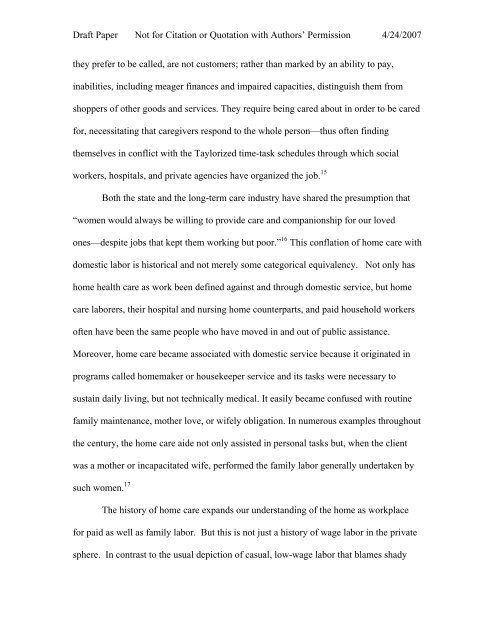Organizing Home Care: - School of Social Service Administration
Organizing Home Care: - School of Social Service Administration
Organizing Home Care: - School of Social Service Administration
Create successful ePaper yourself
Turn your PDF publications into a flip-book with our unique Google optimized e-Paper software.
Draft Paper Not for Citation or Quotation with Authors’ Permission 4/24/2007<br />
they prefer to be called, are not customers; rather than marked by an ability to pay,<br />
inabilities, including meager finances and impaired capacities, distinguish them from<br />
shoppers <strong>of</strong> other goods and services. They require being cared about in order to be cared<br />
for, necessitating that caregivers respond to the whole person—thus <strong>of</strong>ten finding<br />
themselves in conflict with the Taylorized time-task schedules through which social<br />
workers, hospitals, and private agencies have organized the job. 15<br />
Both the state and the long-term care industry have shared the presumption that<br />
“women would always be willing to provide care and companionship for our loved<br />
ones—despite jobs that kept them working but poor.” 16 This conflation <strong>of</strong> home care with<br />
domestic labor is historical and not merely some categorical equivalency. Not only has<br />
home health care as work been defined against and through domestic service, but home<br />
care laborers, their hospital and nursing home counterparts, and paid household workers<br />
<strong>of</strong>ten have been the same people who have moved in and out <strong>of</strong> public assistance.<br />
Moreover, home care became associated with domestic service because it originated in<br />
programs called homemaker or housekeeper service and its tasks were necessary to<br />
sustain daily living, but not technically medical. It easily became confused with routine<br />
family maintenance, mother love, or wifely obligation. In numerous examples throughout<br />
the century, the home care aide not only assisted in personal tasks but, when the client<br />
was a mother or incapacitated wife, performed the family labor generally undertaken by<br />
such women. 17<br />
The history <strong>of</strong> home care expands our understanding <strong>of</strong> the home as workplace<br />
for paid as well as family labor. But this is not just a history <strong>of</strong> wage labor in the private<br />
sphere. In contrast to the usual depiction <strong>of</strong> casual, low-wage labor that blames shady
















